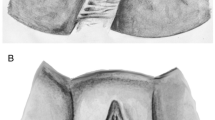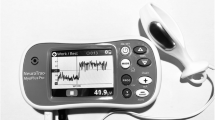Abstract
Pelvic floor muscle (PFM) strength measurement provides useful information for the study of pelvic floor dysfunctions. Vaginal digital palpation, intravaginal pressure measurements, and the use of a dynamometric speculum represent currently available clinical methods for evaluating PFM strength. However, none of these methods provide a dynamic measurement of pelvic floor strength in multiple directions simultaneously. The aim of the present paper is to report the development and first measurement trial of a device that follows the vaginal canal morphology and is able to measure pelvic floor strength multidirectionally.





Similar content being viewed by others
References
ANSI (American National Standards Institute): ISO 376-1999; Metallic material calibration of force-proving instruments used for the verification of uniaxial testing machines.
Bo, K. Pressure measurements during pelvic floor muscle contractions: The effect of different positions of the vaginal measurements device. Neurourol. Urodyn. 11:107-113, 1992. doi:10.1002/nau.1930110205
Bo, K. Pelvic floor muscles training is effective in treatment of female stress urinary incontinence, but how does it work? Int. Urogynecol. J. Pelvic Floor Dysfunct. 15:76-84, 2004. doi:10.1007/s00192-004-1125-0
Bo, K., B. Kvarstein, R. R. Hagen, S. Larsen. Pelvic floor muscle exercise for the treatment of female stress urinary incontinence: II. Validity of vaginal pressure measurements of pelvic floor muscle strength and the necessity of supplementary methods for control of correct contraction. Neurourol. Urodyn. 9:479-487, 1990. doi:10.1002/nau.1930090504
Bo, K., M. Sherburn. Evaluation of female pelvic floor muscle function and strength. Phys. Ther. 85:269-282, 2005.
Bump, R. Assessment of Kegel pelvic muscle exercises performance after brief verbal instruction. Am. J. Obstet. Gynecol. 165:322-328, 1991.
Constantinou, C. E, S. Omata. Direction sensitive sensor probe for the evaluation of voluntary and reflex pelvic floor contractions. Neurourol. Urodyn. 26(3):386-391, 2007. doi:10.1002/nau.20263
Constantinou, C. E., S. OMATA, Y. Yoshimura, Q. Peng. Evaluation of the Dynamic Responses of Female Pelvic Floor Using a Novel Vaginal Probe. Ann. N.Y. Acad. Sci. 1101:297-315, 2007. doi:10.1196/annals.1389.020
DeLancey, J. O. The hidden epidemic of pelvic floor dysfunction: achievable goals for improved prevention and treatment. Am. J. Obstet. Gynecol. 192(5):1488-1495, 2005. doi:10.1016/j.ajog.2005.02.028
De Lancey, J. O., W. W. Hurd. Size of the urogenital hiatus in the levator ani muscle in normal women with pelvic organ prolapse. Obstet. Gynecol. 91:364-368, 1998. doi:10.1016/S0029-7844(97)00682-0
Di Nubile, N.A. Strength training. Clin. Sports Med. 10:33-62, 1991.
Dumoulin, C., D. Gravel, D. Bourbonnais, M. C. Lemieux. Reliability of dynamometric measurements of pelvic floor musculature. Neurourol. Urodyn. 22:134-142, 2004. doi:10.1002/nau.10175
Fialkow, M. F., K. M. Newton, G. M. Lentz, N. S. Weiss. Lifetime risk of surgical management for pelvic organ prolapse or urinary incontinence. Int Urogynecol J Pelvic Floor Dysfunct. 19(3):437-40, 2008. doi:10.1007/s00192-007-0459-9
Guaderrama, N. M., C. W. Nager, J. Liu, D. H. Pretorious, R. K. Mittal. The vaginal pressure profile. Neurourol. Urodyn. 24:243-247, 2005. doi:10.1002/nau.20112
Howard, D., M. J. Miller, J. O. L. Delancey, J. M. M. Ashton-Miller. Differential effects of cough, valsava, and continence status on vesical neck movement. Obstet. Gynecol. 95:535-540, 2000. doi:10.1016/S0029-7844(99)00618-3
Morin, M., D. Bourbonnais, D. Gravel, C. Dumoulin, M. C. Lemieux. Pelvic floor muscle function in continent and stress urinary incontinence women using dynamometric measurements. Neurourol. Urodyn. 23:668-674, 2004. doi:10.1002/nau.20069
Morkved, S., K. A. Salvesen, K. Bo, S. Eik-Nes. Pelvic floor muscle strength and thickness in continent and incontinent nulliparous pregnant women. Int Urogynecol J Pelvic Floor Dysfunct. 15:384-390, 2004. doi:10.1007/s00192-004-1194-0
Norton, P., L. S. Mc Donald, P. M. Sedgwick, S. L. Stanton. Distress and delayed associated with urinary incontinence, frequency and urgency in women. BMJ. 297:1197-1199, 1988. doi:10.1136/bmj.297.6657.1187
Peng, Q., R. C. Jones, K. Shishido, C. E. Constantinou. 2D Ultrasound image processing in indentifying responses of urogenital structures to pelvic floor muscle activity. Ann. Biomed. Eng. 34(3):477-493, 2006. doi:10.1007/s10439-005-9059-3
Peng, Q., R. C. Jones, K. Shishido, S. Omata, C. E. Constantinou. Spatial distribution of vaginal closure pressures of continent and stress urinary incontinent women. Physiol. Meas. 28:1429-1450, 2007. doi:10.1088/0967-3334/28/11/009
Saleme, C. S., S. Del Vecchio, A. Araujo, D. N. Rocha, and M. Pinotti. Device to measure isometric multidirectional force of the pelvic floor muscles (in Portuguese), Brazilian Patent Office PI0705918-3, June 1, 2007.
Saleme, C. S., D. N. Rocha, M. Pinotti, A. Silva Filho, and S. Del Vecchio. Development of a multidirectional device to measure pelvic floor strength. In: Proceedings of the 19th International Congress of Mechanical Engineering, edited by E. Mamiya. Rio de Janeiro: Brazilian Society of Mechanical Sciences and Engineering, 2007, pp. 1–6.
Sampselle, C. M., J. M. Miller, B. L. Mims. Effect of pelvic muscle exercise on transient incontinence during pregnancy and after child birth. Obstet. Gynecol. 91:406-412, 1998. doi:10.1016/S0029-7844(97)00672-8
Shishido, K., Q. Peng, R. Jones, S. Omata, C. E. Constantinou. Influence of pelvic floor muscle contraction on the profile of vaginal closure pressure in continent and stress urinary incontinent women. J. Urol. 179(5):1917-1922, 2008. doi:10.1016/j.juro.2008.01.020
Schull, B. L., G. Hurt, J. Laycock, H. Palmtag, Y. Young, R. Zubirta. Physical Examination. In: Abrahms.P, Cardozo.L, Khoury, S, Wein. A, eds. Incontinence.Plymouth, UK: Plymbridge3 Distributors Ltd., 2002, pp 373-388.
Verelst, M., G. Leivseth. Are fatigue and disturbances in pre-programmed activity of pelvic floor muscles associated with female stress urinary incontinence? Neurourol. Urodyn. 23:143-147, 2004. doi:10.1002/nau.20004
Acknowledgments
The financial support of CNPq, CAPES, and FAPEMIG is gratefully acknowledged. The authors wish to thank technical help of Dr. Jorge Saffar (Setor Testes Físicos, CETEC-MG), Eng. Alexandre Araújo (BIOS Eletrônica e Informática Ltda.), and Mr. João Batista (Oficina da Física/UFMG).
Ethical Issues—Research authorization. The present research was approved by the UFMG Ethics Committee (COEP-UFMG n° 289/06) and was registered in the Brazilian National System of Ethics Committee (SISNEP) as CAAE—0289.0.203.000-06.
Author information
Authors and Affiliations
Corresponding author
Rights and permissions
About this article
Cite this article
Saleme, C.S., Rocha, D.N., Del Vecchio, S. et al. Multidirectional Pelvic Floor Muscle Strength Measurement. Ann Biomed Eng 37, 1594–1600 (2009). https://doi.org/10.1007/s10439-009-9728-8
Received:
Accepted:
Published:
Issue Date:
DOI: https://doi.org/10.1007/s10439-009-9728-8




